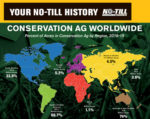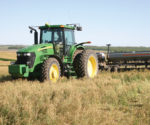Advertise Follow Us
Items Tagged with 'South America'
ARTICLES
No-Till Grows Beyond The Borders
Controlled traffic, cover crops and continuous no-till are boosting yields and profitability in South America, Australia and elsewhere as worldwide no-till acres near 300 million.
Read More
6 Advancements That Have Helped No-Till Grow
Agricultural manufacturers and farmers have played key roles in the development of no-till from its pioneering days to its modern-day look.
Read More
Cover Crops Make Long-Term No-Till Perform Even Better
Iowa no-tiller drills cereal rye as soon as possible after harvesting corn and soybeans for maximum growth and better soil structure
Read More
Tough No-Till Competition
In the late 1960s and early 1970s, we taught Brazilian farmers how to no-till successfully. Now, they’re kicking our butts in the worldwide export market due to lower cropping costs and a tremendous boost in no-tilled acres.
Read More
Why You’re On The Right Track With No-Till
The long-term conversion to no-till could have more impact than any other innovation on Third World food production.
Read More










